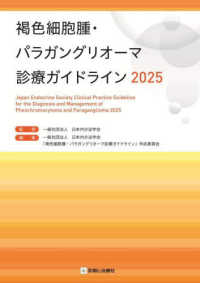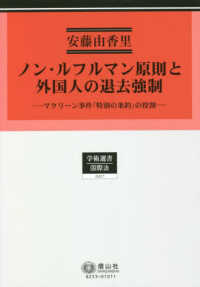- ホーム
- > 洋書
- > 英文書
- > Psychology
Full Description
An up-to-date resource with the latest achievement tests, theories, and evidence-based findings
The Second Edition of this critically acclaimed reference features the most up-to-date versions of assessment instruments to measure individual achievement and learning disabilities. The authors' pragmatic approach offers practitioners an innovative, systematic assessment framework that applies Cattell-Horn-Carroll (CHC) cognitive theory and blends cognitive testing and Response-to-Intervention (RTI) methods into one seamless process for diagnosing learning disabilities. Replete with case studies, checklists, and worksheets, this reference assists practitioners in choosing appropriate tests, organizing comprehensive assessments, and interpreting results using a cross-battery approach.
* Part One focuses on the evaluation and identification of learning disabilities, particularly from the perspective of IDEA 2004. Current cognitive theory, research, assessment methods, and interpretive techniques are all set forth and reviewed.
* Part Two is the "Desk Reference" section. It features descriptions and reviews of the psychometric, theoretical, and qualitative features of more than 50 achievement tests published between 1995 and 2006. Separate chapters are devoted to comprehensive tests of academic achievement and brief screening tests of academic achievement, as well as separate chapters for tests of reading, math, written language, oral language, and phonological processing.
* Part Three provides a comprehensive, step-by-step explanation of evaluating suspected learning disabilities according to IDEA 2004 guidelines, using the principles and procedures described in the previous two parts.
This reference concludes with fifteen appendices providing practitioners with a host of useful information and tools, including reproducible worksheets, conversion tables, and learning disability resources. Grounded in CHC theory and a cross-battery approach to assessment, this is an essential resource for school psychologists and other practitioners who need to assess learning disabilities.
Contents
Preface. Acknowledgments.
PART ONE: EVALUAION AND IDENTIFICATION OF LEARNING DISABILITY FOLLOWING IDEA 2004-CURENCY THOEYR, RESEARCH, ASSESSMENT METHODS, AND INTERPRETIVE TECHNIQUES.
Chapter 1. Academic Achievement and Learning Disabilities.
Chapter 2. Academic Achievement and the Cattell-Horn-Carroll (CHC) Theory.
Chapter 3. A Modern Operational Definition of Learning Disability.
Chapter 4. Assessment of Academic Achievement Using Cross-Battery Methods.
Chapter 5. Integration and Interpretation of Academic and Cognitive Ability Data.
PART TWO: DESCRIPTION AND REVIEW OF THE PSYCHOMETRIC, THEORETICAL, AND QUALITATIVE FEATURES OF ACHIEVEMENT TESTS PUBLISHED BETWEEN 1996 AND 2006.
Chapter 6. Introduction to the Achievement Test Desk Reference.
Chapter 7. Comprehensive tests of Academic Achievement.
Chapter 8. Brief/Screening Tests of Academic Achievement.
Chapter 9. Reading Tests.
Chapter 10. Math tests.
Chapter 11. Written Language Tests.
Chapter 12. Oral Language Tests.
Chapter 13. Phonological Processing Tests.
PART THREE: A COMPREHENSIVE STEP-BY-STEP EXPLANATIN OF EVALUATION OF SUSPECTED LD FOLLOWING IDEA 2004.
Chapter 14. Comprehensive Framework for LD Determination: A Case Study.
Chapter 15. Case Report.
Appendices.
Appendix A. CHC Cross-Battery Worksheets.
Appendix B. Percentile Rank and Standard Score Conversion Table.
Appendix C. test Reviews and Validity Evidence Reported in the Literature.
Appendix D1. Level I-A of LD Operational Definition: Summary Table and Graph for Academic Achievement Test Results.
Appendix D2. Level II-A of LD Operational Definition: Summary Table and Graph for Cognitive Ability test results.
Appendix D3. Level III of LD Operational Definition: Summary Table and Graph for All Standardized test Results.
Appendix E. Level I-A of LD Operational Definition: Summary Table and Graph for IDEA 2004 Achievement Clusters.
Appendix F1. Variations in Task Characteristics of Basic reading Skill/Reading Fluency Skills Tests.
Appendix F2. Variations in Task Characteristics of reading Comprehension Tests.
Appendix F3. Variations in Task Characteristics of Written Expression Tests.
Appendix F4. Variations in Task Characteristics of Math Calculation Tests.
Appendix F5. Variations in Task Characteristics of Math Problem Solving Tests.
Appendix F6. Variations in Task Characteristics of Listening Comprehension Tests.
Appendix F7. Variations in Task Characteristics of Oral Expression Tests.
Appendix G. Learning Disability Resources.
References.
Author Index.
Subject Index.








